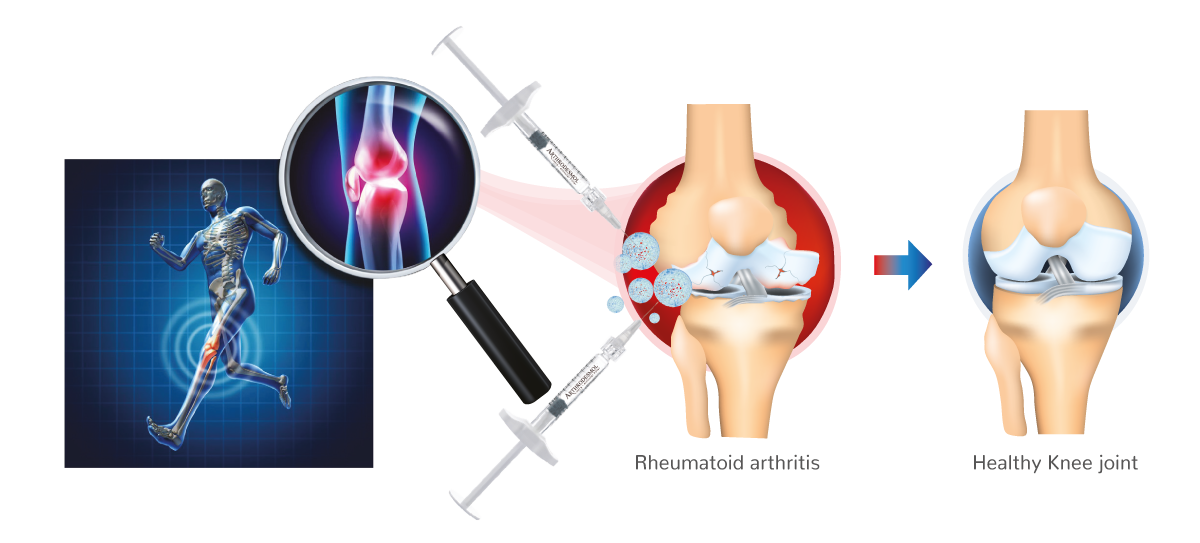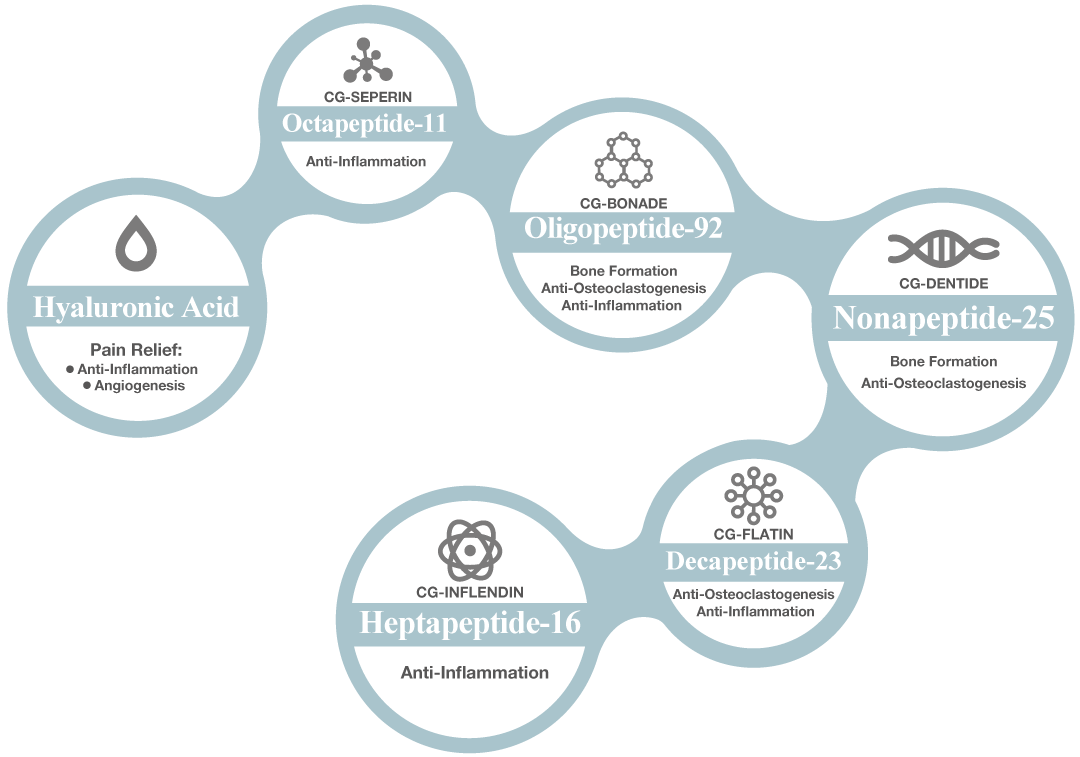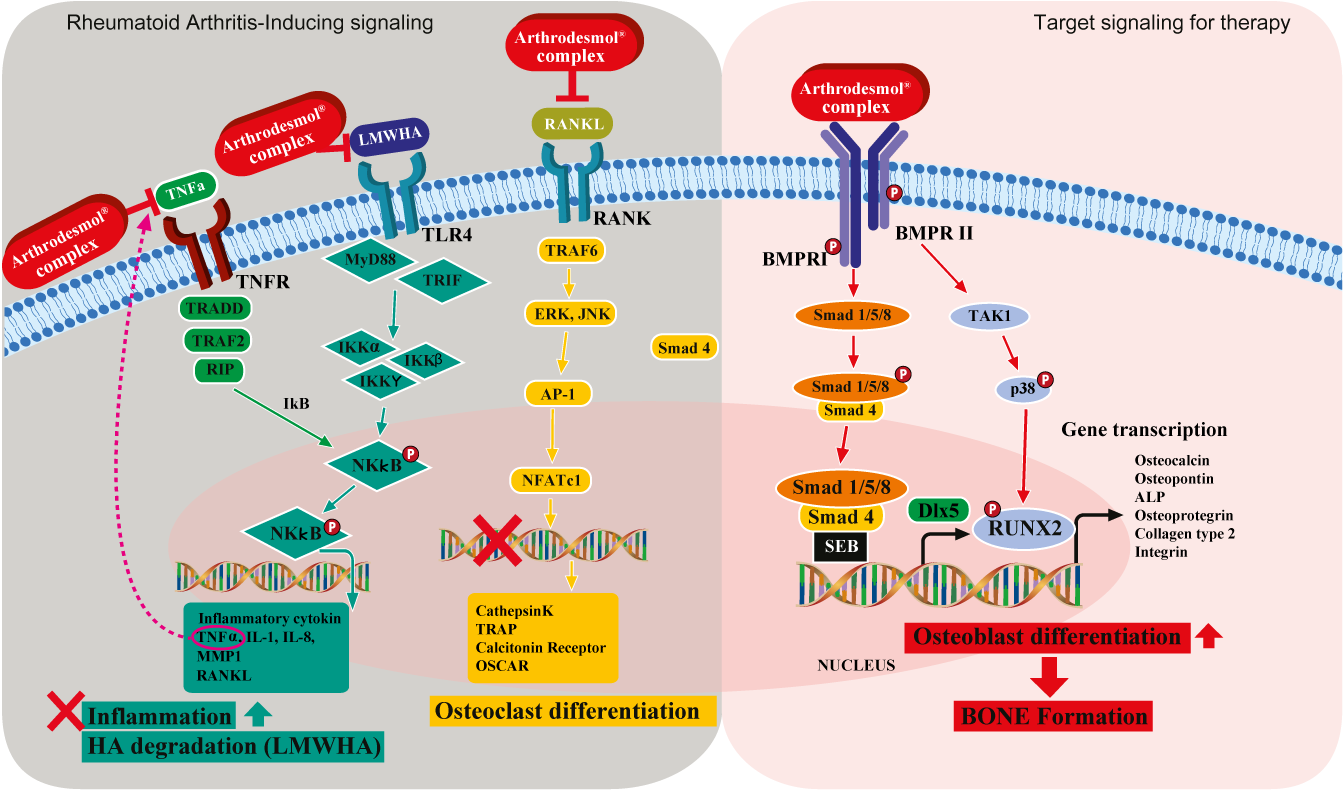
Sustained Release & Peptide Technology


Signaling pathway of ARTHRODESMOL
intra articular filler

TNFR signaling pathway activated by TNFα : blocked by CG-Inflendin / CG-Flatin (Anti-inflammation)
Often, the arthritis including the rheumatoid starts with the inflammation in synovial membrane of the joint.
The expression of inflammatory cytokine such as TNFα, IL-1, IL-8, MMP, and RANKL is strong in inflammatory tissue.
One TNFα binds to the TNF receptor (TNFR), it leads to the expression of TRADD, TRAF2, RIP.
TRADD, TRAF2, RIP are the signaling molecules expressed by the binding of TNFα to its binding site, and expression of these molecules lead to the phosphorylation of NKkB.
Then Phosphorylated NKkB promotes the synthesis of inflammatory cytokine such as TNFα, IL-1, IL-8, MMP, and RANKL.
So this pathway is cycling.
More and more inflammatory cytokines in body lead to the stimulation of inflammatory cytokine synthesis, and the vicious cycle of inflammation starts.
CG-Inflendin and CG-Flatin blocks the binding of TNFα to its binding site, so it can also stop the cycle of inflammation.
TLR4 signaling pathway activated by LMWHA (Low Molecular Weight Hyaluronic Acid): blocked by CG-Seperin (Anti-inflammation)
CG-Seperin is a MMP blocker and also the inhibitor of LMWHA binding to TLR4 site.
Low Molecular weight HA is degraded hyaluronic acid which also causes inflammation by promoting synthesis of inflammatory cytokines.
Once LMWHA binds to TLR4, MyD88 and TRIF (signaling molecules) expressed, and they lead to the expression of IKK molecules,
then expression of IKK molecules lead to the phosphorylation of NKkB.
So as a result, synthesis of inflammatory cytokine such as TNFα, IL-1, IL-8, MMP, and RANKL happens.
CG-Seperin down regulates the breakdown of HA, so it keeps the HA to have higher molecular weight.
RANK signaling pathway activated by RANKL : blocked by CG-Bonade / CG-Dentide (Anti-osteoclastogenesis)
RANKL is a cytokine which promotes the osteoclastogenesis.
Osteoclast is the changed form of bone tissue, and it leads to the damage in bone tissue.
Binding of RANKL to its binding site leads to TRF6 expression → ERK, JNK → AP-1 →NFATc1 expression.
Then this pathway ends up with the expression of the gene which promotes the osteoclastogenesis.
CG-Bonade and CG-Dentide blocks the RANKL binds to its binding site, so it inhibits the osteoclastogenesis.
You can see its efficacy in osteoclastogenesis inhibition in the in-vitro study data C. in the leaflet too.
BMPR signaling pathway activated by CG-Bonade / CG-Dentide (Bone formation)
Not only inhibiting the RANKL, CG-Bonade and CG-Dentide also binds to the BMP binding site and promotes the bone formation.
CG-Bonade and CG-Dentide can binds to the BMPR and activate BMP pathway.
This signaling pathway ends up to the expression of gene transcription for bone formation including the osteoblast (bone cell) genesis.
By this bone formation, the cartilage (bone tissue) can be regenerated through the time.
TRADD, MyD88, TRAF6, and etc are the signaling molecules in cytosol, and the expression of each molecule leads to the expression of another signaling molecule in the path way.
Unique HA* with a Specific Extracellular Peptides
Mimics Matrix for a reponse of OA
HA – High Quality – Pharmaceutical Degree – CEP
Hyaluronic acid (HA), the main component of extracellular matrix, is considered one of the key players in the tissue regeneration process. It has been proven to modulate via specific HA receptors, inflammation, cellular migration, and angiogenesis, whic are the main phases of wound healing. The role of HA in 2 major steps of wound healing is examined: inflammation and the angiogenesis process. Finally, the antioxidative properties of HA are discussed and its possible clinical implication presented. (1)
- Hyaluronic Acid in Inflammation and Tissue Regeneration- Authors:Malgorzata Litwiniuk, Alicja Krejner, Tomasz Grzela: March 2016-Issue: Volume 28 – Issue 3 – March 2016- ISSN: 1044-7946- ndex: Wounds 2016;28(3):78-88
https://Arthrodesmol.woundsresearch.com/article/hyaluronic-acid-inflammation-and-tissue-regeneration
Arthrodesmol contains a unique HA (Low Molecular Eeight HA) obtained by fermentation. The quality of HA is granted by CEP certification.
HA’s Arthrodesmol is the unique manufacturer by encimatic degradation.
Biomimetic Matrix Peptides Specific in OA
- Stopping the cartilage degradation and joint degeneration.
- Decrease the synovial inflammation – pain relief.
- Peptides used to block cytokines – Anti-inflammatory and pain relief.
- Peptides improve the pain control, because of the different action mechanisms in the knee joint.
- Clinical studies demonstrate the efficacy regarding the decreasing of pain after one week vs convectional treatment witch showed an improvement after 3 months. (1)
Benefits of Peptides in OA
Osteoarthritis (OA) is the most common degenerative joint disease characterized by articular cartilage degradation, joint degeneration, synovial inflammation and changes in periarticular and subchondral bone, being a leading cause of disability. The articular cartilage is mainly formed by chondrocytes and a collagen-proteoglycan extracellular matrix that contains high levels of glycosylated proteins. The Metastatic cell phenotype or Sialyated glycoproteins as peptides, attenuates NF-kB activation, protecting chondrocytes from arthritic insults that lead to articular cartilage degradation. (1)
Recently studies demonstrate that the use specific peptides which combines with a high-quality Hyaluronic Acid:
Provide support for neo-tissue osteochondral repair/regeneration whilst conferring proper mechanical and functional features as well as protecting biomolecular agents from premature degradation.
Challenges used in biomaterials functionalization with peptides that can mimic ECM proteins or other natural soluble biomolecules, important to induce the complex interactions between cells and the ECM. Treating OA by means of peptide-biofunctionalization of biomaterials which can be designed to be recognizable, induce differentiation, prevent infection, degrade at an intended rate or act as drug delivery systems for controlled release or even as simple triggers of cell behavior. (2)
Peptide and peptidomimetic-based approaches in the treatment of inflammatory arthritis is the key process influencing an inflammatory response. Peptides used to block cytokines. (3)
The conclusion of this Scientifics Reviews supports that the specifics peptides used in Arthrodesmol intra – articular filler has been combined with HA to develop transmembrane peptides and obtain maximum potential efficacy in degeneration by arthritis.
OCTAPEPTIDES – CG SEPERIN
Octapeptides reducing the production of cytokines (IL-17, IL-23, IL-6 and TNF-α) and chemokines monocyte chemoattractant protein 1 in the joints of arthritic or in synovial cell culture supernatant, and increased the levels of IFN-γ and TGF-β.
- Is effective in suppressing both inflammatory and Th17 responses in CIA.
- Represent a new therapeutic modality for rheumatoid arthritis. (4)
OLIGOPEPTIDES – CG BONADE
- BONE FORMATION: The results suggest that acidic oligopeptide is useful for drug delivery to bone and E2-(L-Asp)6 is a good candidate as an anti-osteoporosis drug without the adverse side effects of E2. (5)
- ANTI-OSTEOCLASTOGENESIS: The shTACE/peptide carrier complex alleviate arthritic symptoms in collagen induced arthritis (CIA) models by demonstrating enhanced anti-inflammatory and anti-osteoclastogenic effects. (6)
- ANTI-INFLAMMATORY: This peptide inhibits the biological activities of IL-6 in vitro and in vivo. This approach is an interesting development among other strategies aimed at targeting IL-6 in inflammatory diseases. (7)
NONAPEPTIDES – CG DENTIDE
- BONE FORMATION: this peptide in binding to transmembrane proteins to promote intracellular events leading to cell functions. It promote bone formation without any recognizable antigenic activity. Its potential application value for regenerative medicine, especially for bone tissue engineering. (8)
- ANTI-OSTEOCLASTOGENESIS: Receptor activator of nuclear factor-κB (RANK) and RANK ligand play a pivotal role in bone metabolism, and selective targeting of RANK signaling has become a promising therapeutic strategy in the management of resorptive bone diseases. Nonapeptides is a small peptide inhibitors specifically targeting the receptor RANK and it is new therapeutic opportunity for the treatment of resorptive bone-disease. (9)
DECAPEPTIDES – CG FLATIN
- ANTI-INFLAMMATORY: the decapeptide is a potent anti‐inflammatory peptide that has potential therapeutic applications, especially for PLA2‐ in synovial fluid from patients with RA inflammatory arthritis. (10)
- ANTI-OSTEOCLASTOGENESIS: Activate the proliferation of type II collagen specific T cell response and antibody formation in rheumatoid arthritis (RA) and their relations to HLA-DR4 subtype. (11)
HEPTAPEPTIDE – CG INFLENDIN
- ANTI-INFLAMMATORY: the RGD peptide (RGD-4C) was covalently linked to a proapoptotic heptapeptide binds selectively to the αvβ3 and αvβ5 integrins accumulated in inflamed synovium but not in normal synovium. Homing of RGD-4C phage to inflamed synovium was inhibited by co-administration of soluble RGD-4C. Intravenous injections of the RGD-4C–D(KLAKLAK) 2chimeric peptide significantly decreased clinical arthritis and increased apoptosis of synovial blood vessels, whereas treatment with vehicle or uncoupled mixture of the RGD-4C and the untargeted proapoptotic peptide had no effect. Targeted apoptosis of synovial neovasculature caninduce apoptosis and suppress clinical arthritis. This form of therapy has potential utility in the treatment of inflammatory arthritis. (12)
